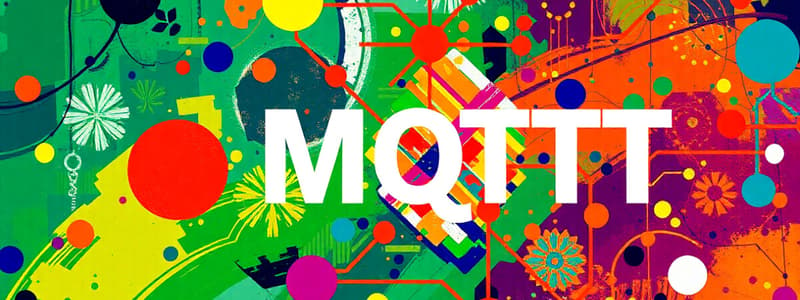Podcast
Questions and Answers
Which MQTT Quality of Service (QoS) level provides 'at least once' delivery?
Which MQTT Quality of Service (QoS) level provides 'at least once' delivery?
- QoS Level 3
- QoS Level 0
- QoS Level 2
- QoS Level 1 (correct)
RESTful web services are well-suited for resource-constrained IoT networks due to their low overhead.
RESTful web services are well-suited for resource-constrained IoT networks due to their low overhead.
False (B)
What transport protocol does CoAP use to reduce overhead?
What transport protocol does CoAP use to reduce overhead?
UDP
In MQTT, a central message ______ handles subscriptions and topic management.
In MQTT, a central message ______ handles subscriptions and topic management.
Match the following MQTT concepts with their descriptions:
Match the following MQTT concepts with their descriptions:
Which MQTT feature allows a client to store a message that will be sent by the broker if the client disconnects unexpectedly?
Which MQTT feature allows a client to store a message that will be sent by the broker if the client disconnects unexpectedly?
MQTT-SN is designed for TCP/IP networks.
MQTT-SN is designed for TCP/IP networks.
What is the main function of an MQTT-SN gateway?
What is the main function of an MQTT-SN gateway?
A RESTful web service uses ______ methods such as GET, PUT, POST, and DELETE.
A RESTful web service uses ______ methods such as GET, PUT, POST, and DELETE.
Match the CoAP message types with their descriptions:
Match the CoAP message types with their descriptions:
Which type of MQTT-SN gateway maintains a single connection to the MQTT broker while managing multiple MQTT-SN clients?
Which type of MQTT-SN gateway maintains a single connection to the MQTT broker while managing multiple MQTT-SN clients?
CoAP's 'Observe' option requires clients to continuously poll for resource state changes.
CoAP's 'Observe' option requires clients to continuously poll for resource state changes.
In the context of RESTful web services, what does the acronym URI stand for?
In the context of RESTful web services, what does the acronym URI stand for?
MQTT messages consist of a fixed header, a variable header, and an optional ______ containing the actual data.
MQTT messages consist of a fixed header, a variable header, and an optional ______ containing the actual data.
Match the following steps with the MQTT QoS Level 2 handshake process:
Match the following steps with the MQTT QoS Level 2 handshake process:
What is a key limitation of a transparent MQTT-SN gateway compared to an aggregating gateway?
What is a key limitation of a transparent MQTT-SN gateway compared to an aggregating gateway?
CoAP inherently provides built-in QoS mechanisms on par with TCP's reliability features.
CoAP inherently provides built-in QoS mechanisms on par with TCP's reliability features.
Explain the significance of binary encoding in CoAP compared to the text-based encoding used in standard HTTP.
Explain the significance of binary encoding in CoAP compared to the text-based encoding used in standard HTTP.
In RESTful communication, the server responds to a client's request with data and a ______ code indicating the status of the request.
In RESTful communication, the server responds to a client's request with data and a ______ code indicating the status of the request.
Which step in the MQTT QoS level 2 handshake involves receiver informing sender that it has received the message?
Which step in the MQTT QoS level 2 handshake involves receiver informing sender that it has received the message?
Flashcards
MQTT
MQTT
A lightweight messaging protocol based on TCP, suitable for resource-constrained IoT devices using unreliable or low-bandwidth networks.
MQTT Broker
MQTT Broker
A central component in MQTT that handles subscriptions and topic management, facilitating indirect communication between devices.
MQTT Quality of Service (QoS)
MQTT Quality of Service (QoS)
The level of guarantee of message delivery in MQTT, ranging from 'at most once' to 'exactly once'.
MQTT Retained Messages
MQTT Retained Messages
Signup and view all the flashcards
MQTT Last Will and Testament
MQTT Last Will and Testament
Signup and view all the flashcards
MQTT-SN
MQTT-SN
Signup and view all the flashcards
MQTT-SN Aggregating Gateway
MQTT-SN Aggregating Gateway
Signup and view all the flashcards
RESTful Web Service
RESTful Web Service
Signup and view all the flashcards
Constrained Application Protocol (CoAP)
Constrained Application Protocol (CoAP)
Signup and view all the flashcards
CON (Confirmable) messages in CoAP
CON (Confirmable) messages in CoAP
Signup and view all the flashcards
NON (Non-Confirmable) messages in CoAP
NON (Non-Confirmable) messages in CoAP
Signup and view all the flashcards
CoAP Observe Option
CoAP Observe Option
Signup and view all the flashcards
Study Notes
- IoT is expanding, increasing the number of connected devices and the need for effective communication protocols.
- Messaging protocols in IoT architectures manage communication at the application layer.
Common IoT Communication Protocols
- Message Queuing Telemetry Transport (MQTT): Lightweight publish-subscribe messaging ideal for constrained devices.
- Representational State Transfer (RESTful): Stateless, widely-used protocol relying on HTTP, suitable for diverse applications.
- Constrained Application Protocol (CoAP): Specifically designed for resource-limited IoT devices, uses UDP which facilitates low overhead.
- These protocols must function across varied electronic devices with differing hardware specifications, presenting interoperability challenges.
MQTT
- It is a lightweight messaging protocol, based on TCP, suitable for resource-constrained IoT devices using unreliable or low-bandwidth networks.
- Devices communicate indirectly via a central message broker using a publish/subscribe model.
- The central message broker handles subscriptions and topic management.
MQTT Messages
- Composed of a fixed header (minimum 2 bytes), a variable header (optional, up to 12 bytes), and an optional payload.
- The variable header contains details like quality of service (QoS) level, connection flags (username/password access), keep-alive timing and the topic names.
- The actual data is contained within the optional payload (not present in all message types).
MQTT Special Features
- Retained Messages: The broker saves the latest message per topic to resend upon client subscription or reconnection.
- Last WILL and Testament: Clients store messages to inform subscribers automatically if unexpected disconnections occur.
- Persistent Sessions: The broker stores subscription information and undelivered messages, automatically resuming upon client reconnection.
MQTT Quality of Service Levels
- There are three QoS levels to ensure reliable message delivery
QoS Level 0
- Delivery Approach: "At most once" (fire and forget).
- Acknowledgment: No acknowledgment is awaited.
- Message Handling: No retransmission; sender does not know if the message was received.
- Lightweight: Most lightweight QoS level.
QoS Level 1
- Delivery Approach: "At least once".
- Acknowledgment: Sender waits for an acknowledgment from the receiver.
- Message Handling: Each message has a unique packet identifier in the variable header.
- Acknowledgment Message: Receivers send a PUBACK message with the packet identifier.
QoS Level 2
- Delivery Approach: "Exactly once" (safest but slowest).
- Handshake: Requires a four-part handshake (request/response flows).
QoS Level 2 Process
- Step 1: Sender sends a PUBLISH packet with a unique packet identifier.
- Step 2: Receiver acknowledges with a PUBREC packet.
- Step 3: Sender replies with a PUBREL packet to release the message.
- Step 4: Receiver forwards the message to subscribers and responds with a PUBCOMP packet to confirm completion.
- Retransmission occurs if the sender does not receive a PUBREC within a specified time
MQTT-SN
- It is an extension of MQTT designed for low-cost, low-power devices, and constrained networks like Wireless Sensor Networks (WSNs).
- Optimized for embedded devices on non-TCP/IP networks (e.g., ZigBee).
MQTT-SN Components
- MQTT-SN Client: Publishes data and connects to an MQTT-SN Gateway.
- MQTT-SN Gateway: Connects WSN nodes with MQTT brokers and translates between MQTT-SN and MQTT.
Gateway Types
- Transparent Gateway: Serves one MQTT-SN client and maintains a direct connection to the MQTT broker.
- Transparent Gateways can lead to scalability problems as each client needs a dedicated gateway.
- Aggregating Gateway: Manages multiple MQTT-SN clients and maintains a single connection to the MQTT broker.
- Aggregating Gateways reduce message overhead by preprocessing messages.
Gateway Integration Types
- Integrated Gateway: Embedded within an MQTT broker.
- Stand-Alone Gateway: Operates independently from the MQTT broker.
MQTT-SN Offers
- Point-to-Point Data Transfer: Unicast service for messages between two endpoints.
- Broadcast Service: Ensures messages from a node can be received by all nodes within its transmission range.
- Multiple Gateway Connection: Clients can connect to multiple gateways simultaneously.
RESTful Web Service
- These use the REST architecture, based on a request-response model using the HTTP protocol and HTTP methods: GET, PUT, POST, DELETE.
- Servers expose resources (e.g., text, images, sensors) identified uniquely by a URI.
RESTful Web Service Communication Involves Three Steps
- Connection establishment (TCP three-way handshake: SYN, ACK exchanges).
- Request/Response exchange (server replies with data and status code).
- Connection closing (again via TCP three-way handshake).
RESTful Web Service Challenges
- HTTP has no message-size limit, causing large overhead.
- Every request includes all control information due to the statelessness of RESTful, increasing message size and latency.
- TCP connection setup/teardown generates overhead, problematic for real-time and small data transmissions.
- QoS support relies solely on TCP reliability, with no additional built-in QoS mechanisms.
- RESTful (HTTP/TCP) is inefficient for constrained IoT networks, thus, alternative REST-based protocols (e.g., CoAP) have been developed.
Constrained Application Protocol (CoAP)
- Designed for constrained environments with special requirements.
- Uses binary encoding for headers, methods, and status codes to reduce overhead.
- Runs over UDP instead of TCP, which reduces overhead but affects reliability.
CoAP Protocol Layers
- Request/Response Layer implements the RESTful paradigm and supports HTTP-like methods: GET, PUT, POST, DELETE.
- Provides basic RESTful services and can interact with HTTP through proxies/gateways.
- CoAP messages use UDP for asynchronous exchanges and have low header overhead.
- Example URI format: coap://example.com:5683/sensors/temp.json
- Message Layer handles retransmission of lost packets and defines four message types: CON, NON, ACK, RST.
- CON (Confirmable): Requires acknowledgment (ACK) for reliable communication.
- NON (Non-Confirmable): Sent without acknowledgment, used for periodic data.
- ACK (Acknowledgment): Confirms receipt of a CON message.
- RST (Reset): Used to reset communication if needed.
CoAP Additional Features
- Observe Option enhances the request/response model and allows clients to receive notifications of resource state changes without polling.
- The Observe Option adds the client to the list of observers for a specific resource.
CoAP Interoperability
- Fully interoperable with REST through proxies/gateways.
- Supports both request/response and publish/subscribe patterns.
Studying That Suits You
Use AI to generate personalized quizzes and flashcards to suit your learning preferences.




